-

人教版新目标初中英语八年级下册Why don’t you get her a scarf教案
教师带领学生复习有关描述宠物的词汇,采用教师提问学生回答的方进行。如:T:What animals do you think would be good pets?What animals do you think would be bad pets?What do you think are good animals for a six-year-old child?然后学生进行 pairwork 练习。Task two: 师生互动,学习探究 1、播放3a部分的录音,引导学生一边听录音,一边跟读。2、通过听录音学生回答以下问题:Why do you think pot-bellied pigs are popular?What are the advantages and disadvantages of keeping such a pet?教师对学生的回答进行及时点评。3.学习范文,学习重点短语,为下步的模仿写作提供语言素材。T :1. )Have you ever kept a pig as a pet?Do you like pigs? St.:No.…Why don’t you like to keep a pig? St: No.They’re too dirty and lazy(Do you know in some foreign countries like Hollyland, Australia,pigs are the most popular pet.there’s a kind of pig.(图)it has an interesting name? it ‘s called a pot-bellied pig.) Now,let’s learn an article about this kind of interesting pet.2.)play the tapeSt.:Listen and repeat3.)show some Qs on computer(本子St.: read silently,then answerthe Qs(本子)4.)Ask ss. Close book and retell this passage.(what is a pot-bellied pig? Is it a good or bad pet? ) St.: retell it to each other“A pot –bellied pig is a popular pet now…”5.read the article together.St.:.practice reading

人教版新目标初中英语八年级下册Would you mind turning down the music教案
Step 4. Group work (4)1. Ask a pair of students to read the dialogue. Say, This activity provides speaking, listening and writing practice using the target language.2. Ask students to complete the work in groups.3. Check the answers with the whole class. 4. Explain some of the language points. Step 5. Word review (Self check 1)1. Ask students to read the words and the phrases given. 2. Fill in the blanks with proper forms of these words to complete the sentences. 3. Check the answers with the whole class. Homework:Do activity 2 on page 57 after class. Period 6Teaching aims: 1. Teach vocabulary words and the useful expressions. 2. Enable the students to learn etiquette in different culture. 3. Help the students learn how to behave politely in public places and in daily life. Teaching procedures:Step 1. RevisionHelp students to review the function of making requests through a free talk. Then lead them to the topic of etiquette. Explain the meaning of etiquette. Or, ask students to look it up in the dictionary. Step 2. Pre-reading (Section 1)1. Ask students to read the picture and make a list with their partner about how many rules of etiquette can be seen being broken.

人教版新目标初中英语七年级下册How was your weekend教案2篇
Teaching Goal:1. General aims:Talk about recent past events2. Particular aims:A. Language Focus.Talk about recent past events and think of the past events.B. Language goalsHow was….?It was …What did …do over the weekend?C. Language structures:(1). How was your weekend? I was great. Pay attention to no form.(2). What did you do over the weekend? I played soccer. We went to the beach.D. Useful words and phrases:Words: was, did, went, beach, over, project, test, wasn’t, false, number, geography, spend, week, most, mixture, their, had, little, cook, read, saw, change, everyone, sit, sat, no, anythingPhrases: did one’s homework, played soccer, cleaned my room, went to the beach, played tennis, went to the movies, on Saturday morning, over the weekend, cook … for, what about, do some reading, have a party, talk show, go shoppingE. Grammar language:Present simple past tenseRegular and irregular verbsF. Learning strategies:Tour and holidaysG. Interdiscipinary:H. Emotion and manner:Teaching time: 5 periodsTeaching procedures:Period One教学步骤、时间 教师活动 学生活动 媒体应用Step 1Free talk 3’ Ask some questions like:Who’s on duty today?What’s the weather like? Answer and talk about something.让同学们回答下列问题1. Do you like weekend? (Let some students answer)It takes them three minutes to talk about the question.2. Why do you like weekend? (let the students answer) Most of the students like the weekend此时教师用汉语问:“在周末期间问你干了什么?这句话用英语这么回答?Let the students guess.At last the teacher give them right answer3. What did you do over the weekend?(板书、学习)

人教版新目标初中英语七年级下册What does he look like教案3篇
所需要用到的句子:Who is that?That is Jack. I like him.Why do you like him?I like him because he is interesting.Task 4: 设计理想中的人类Step one: 设计理想中的人类的外貌。把全班同学分成若干小组,学生可以边说边在纸上画出他们的模样。Step two: 设计理想中人类的性格。学生们可以把那些能描述性格的单词写在图画的旁边。Step three: 每组选出一名同学,其他同组同学提问,他作简单回答,并说明原因。所需用到的句子:What does he or she look like?He or she ...What is he or she like?He or she is ...Why?Because ...Task 5: 挑战性活动调查性格是天生的还是后天形成的,让每个同学回家去调查一下自己成长过程中性格是否有变化,具体是怎样的,为什么会这样? Teaching Aims:1. Enable students to have a general understanding of how to talk about people's physical appearance.2. Enable students to tackle some essential vocabularies and patterns about describing people. Provide them with necessary skills and methods.3. Create various chances for students to describe the persons they're familiar with, such as classmates, family members, teachers, idols, etc.

人教版新目标初中英语七年级下册Where is the post office教案2篇
Period 2 (3a----Section B 2c)Preview(Pre-task): Key points: What laAdd another information about their pen pals----their language on the cardnguage does she/he speak?She/He speaks....Does she/he have any brothers and sisters? Does she/he speak English?Preview(Pre-task): Add another information about their pen pals----their language on the cardKey points: What language does she/he speak?She/He speaks....Does she/he have any brothers and sisters? Does she/he speak English?Step 1 Revision1.Revisionand dictation of the new words 2.Revise the drills they learned yesterday.(by pairwork and grammar exercise)Step 2 Leading-inT has a conversation with one student. The conversation is following:---Do you have a pen pal?---Yes, I do.---What's your pen pal's name? ---His/Her name is....---Where is your pen pal from? ---He/She is from...---Where does he/she live? ---He/She lives in....---What language does he/she speak?He/She speaks...Write the new words on the Bb. They are following: EnglishChineseJapaneseFrenchStep 3 LearnLearn the new words with the whole class.Finish 3a with the students3b Pairwork T still does an example with one student Then the Ss practise in pairs. The example is following:--Curry Muray is my pen pal. He is from the United States.---What language does he speak?

人教版新目标初中英语七年级下册It’s raining教案2篇
1 Each group choose one place to describe and what you are doing in it Choose one place, and describe what they are doing 2 Move around the room and give suggestions Talk about it and write it down 3 Ask one to show their works and act it Choose one of each group to make a report 4 Evaluate the best group and the best reporter Choose the best one Homework Ask your friends their ideal place and write about it教学反思:新课程标准中强调学生在课堂中的主体地位,在综合课中他们的主体地位就更加突出。在各个活动中给不同程度的学生不同层次的任务,让各层面的学生都有表现发挥的机会,从而产生对英语的兴趣。使用照片图片多媒体来辅助教学,效果更好。同时让了解其他国家风景,风俗的同学介绍ideal place,增加学生的背景知知识,实现跨学科交流的目的。教案点评:采用任务型教学模式,在各个活动中给不同程度的学生不同层次的任务,让各层面的学生都有表现发挥的机会,从而产生对英语的兴趣。使用照片图片多媒体来辅助教学,效果更好。让了解其他国家风景,风俗的同学介绍ideal place,增加学生的背景知识,实现跨学科交流的目的。

人教版新目标初中英语七年级下册Where is your pen pal from教案
2.1Match the country with the language.Step II Reading3a? let the students read the letter fast and answer the questions.? Let the students ask more questions about the letter as possible as the can.Step III Writing3b.Step IV. Pairwork2cStep V Listening2a, 2bStep V. HomeworkExercises book(1) P3Exercises book (2) P3Period FourStep I . Dictate the words and sentences in Unit1.Step II. Self-checkStep III. Check the answers for Exercises book in the unit.Step IV. Home workRevise and preparation for unit 2.教学反思:通过本单元的学习,学生基本可以谈论人们的国籍,居住城市及其所说的语言,通过书信方式去介绍自己并寻找笔友。但在涉及到国外的一些城市时,学生对这方面的知识相对欠缺,能介绍的城市并不多,也反应出学生课前预习不充分,这跟学生学习条件也有关,大多数学生无法通过网络获取所需信息。因此,在以后的教学中要多指导学生通过计算机网络获取信息,拓宽知识面。

人教版新目标初中英语七年级下册What do you think of game shows教案
五、教学Section B-2c1. Pair work: What do you think of the belt/sunglasses/…? What does your father/mother/… think of your scarf/belt…?2. Group work(1). Teacher shows some different kinds of school uniforms (制服)and asks : “ What do you think of your school uniforms? If you have a chance to choose your school uniforms, what kind would you like to choose?”(2). Discuss in groups.(3).Get some Ss to report in class.说明:这一步旨在让学生运用已有的语言知识谈论对事物的看法和意见,并简单阐明理由,培养学生的主动思维能力和运用英语的能力。六、教学拓展调查电视节目的收视率任务:调查你周围的人对现在各种电视节目的反响。活动过程:1.教师布置任务,让学生调查周围的人(包括他的亲戚朋友和邻居)喜欢收看哪方面的电视节目。2.学生进行调查活动,运用本单元所学的句型What do you think of….? (Why?)What's your favorite game shows?What do you think of talk show?I doesn’t mind it.I like it.I love it.I can’t stand it.3.记录下排在前10位的TV Program,填写调查表,比较其收视率。

人教版新目标初中英语七年级下册Where did you go on vacation教案
句型: Where did you go on vacation? I went to summer camp.Did she go to Central Park?Yes,she did.No, she didn’t语法:一般过去时特殊疑问句、一般疑问句及肯、否定回答。课时安排4课时第一课时:Section A:la,1b,lc,2a,2b,2c 第二课时:Section A:3a,3b,4第三课时:Section B:1,2a,2b,2c第四课时:Section B:3a,3b,3c,4 and Self Check第一课时教学目标掌握描写假期生活的形容词。假期里自己所做事情的简单表达。谈论假期做的事情及当时情况。谈论假期时旅游的天气,旅游者以及食物等。教学过程一、导入播放一首英文歌曲:Let’s travel 说明:通过让学生听节奏欢快迪斯尼英语歌曲Let’s travel.引入本节课谈论的话题vacation and travel. 让歌曲使学生的思维活跃,增强课堂气氛,激发学生提高学习英语的兴趣。T:How is the trip ?Ss : It’s pretty good/ happy/exciting /relaxing/busy/dangerous/ fantastic说明:这个问题是为了操练形容词。建议让多个Ss作答。鼓励他们用不同的形容词。上述个别形容词本应在第二课时中出现,但可以在warming-up中第一次非正式出现。这些形容词也可在老师的评价语中适时出现,以加深学生对词汇的印象。

人教版新目标初中英语八年级下册Have you ever been to an amusement park教案
(1)Have you ever been to …? Yes, I have. / Yes, I have ever been to …No, I haven’t. / No, I have never been to …(2)When did you go there? I went there last year. (3)I have never been to a water park. Neither have I. I have ever been to an amusement park. So have I. (4)How long have you been studying English? I’ve been studying English since nine o’clock. I’ve been studying English since I came back home. I’ve been studying English for five hours. (5)What’s that? It’s an amusement park in Japan. I’ve never been to an amusement park like it before. It’s fun to learn another language. Let’s go tonight. Isn’t this great?space museum, amusement park, water park, South America, Peru, Holland, European culture, tour guide, flight attendant, musical instrument, more than, be from, get to, take lessons, neither, discover, graduate, change

人教版新目标初中英语八年级下册It’s a nice day, isn’t it教案2篇
"Hello! Welcome to English class! Introduce yourself. Meet your new classmates." That's what the teacher says. What do you say? "Oh no!" It can be difficult talking to new people. But it can be fun, and you can make friends. How do you do it? Make small talk. Small talk is polite conversation. "Wang Nan is a great pingpang player, isn't she?" "I'd love to meet her, wouldn't you?" "It's been raining a lot, hasn't it?" Tag questions are a form of polite speech. To make small talk successfully, you should know how to make them. You should also know what topics to talk about. Try to learn this unit carefully. The next time you're in English class, you'll find out. Making small talk's easy, isn't it? (“你好!欢迎你!请做一下自我介绍。认识一下你的新同学。”通常在课上老师会这样说。你会说什么呢?“噢,不!”与陌生人谈话太困难了。但是这也很有意思,并且你还能交到朋友。你该怎么做呢?闲聊。闲聊指得是礼貌的对话。“王楠是一个很棒的乒乓球运动员,不是吗?”“我希望自己能认识她,你呢?“今年的雨水很多,不是吗?”反意疑问句是一种礼貌用语。为了使得谈话成功,你应该知道怎样去进行闲聊。你还应该知道与不同的人该谈论什么样的话题。认真的学习这个单元吧,下次在英语课上,你会发现与大家展开谈话是一件很容易的事情,不信我们来试试。)

人教版新目标初中英语八年级下册What were you doing when the UFO arrived教案2篇
(一).知识方面: 1.培养学生能运用过去进行时来描述、谈论过去某个时间正在发生的事情或动作的意识和能力,能就过去某个时间正在发生的动作做出正确的描述。 2.培养学生的想象力和角色扮演的合作能力。 3.培养学生讲述过去发生的事情经过的能力。能正确运用一般过去时来讲述故事。 (二).技能方面: 1.本单元的语言目标是Talk about past events and tell a story(谈论过去的时间和讲述一个故事),围绕这一目标,要涉及句型: What were you doing when the UFO arrived? ----I was sitting in the barber’s chair. The barber was cutting my hair. 因此必须学习standing、studying、cleaning、sleeping、cooking、making、eating、cutting、等表示地点的词,以便为上述句型提供语言材料。2.学习过去进行时的有关知识。Was/were+现在分词,是该时态的表达式。 3.在学习过程中,要区分The boy was walking down the street when the UFO landed.和While the boy was walking down the street, the UFO landed.这两种由when和while引导的状语从句的句型结构。注意它们的不同。
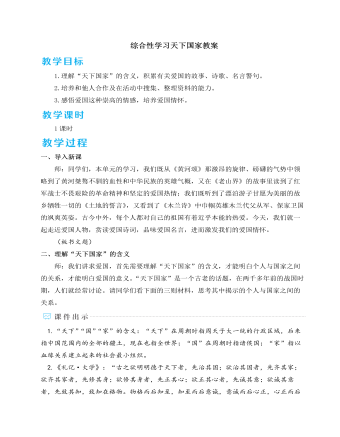
人教部编版七年级下册综合性学习天下国家教案
我荣幸地以中华民族一员的资格,而成为世界公民。我是中国人民的儿子。我深情地爱着我的祖国和人民。 ——邓小平一个人只要热爱自己的祖国,有一颗爱国之心,就什么事情都能解决。什么苦楚,什么冤屈都受得了。 ——冰心做人最大的事情是什么呢?就是要知道怎么样爱国。 ——孙中山能够献身于自己祖国的事业,为实现理想而斗争,这是最光荣不过的事情了。——吴玉章外国爱国名言示例:我们为祖国服务,也不能都采用同一方式,每个人应该按照资禀,各尽所能。——歌德纵使世界给我珍宝和荣誉,我也不愿离开我的祖国。因为纵使我的祖国在耻辱之中,我还是喜欢、热爱、祝福我的祖国。 ——裴多菲我重视祖国的利益,甚于自己的生命和我所珍爱的儿女。 ——莎士比亚我无论做什么,始终在想着,只要我的精力允许我的话,我就要首先为我的祖国服务。 ——巴甫洛夫
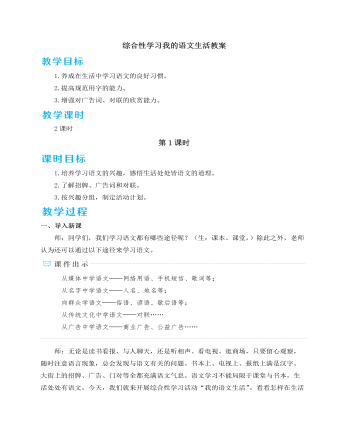
人教部编版七年级下册综合性学习我的语文生活教案
1.培养学习语文的兴趣,感悟生活处处皆语文的道理。2.了解招牌、广告词和对联。3.按兴趣分组,制定活动计划。 一、导入新课师:同学们,我们学习语文都有哪些途径呢?(生:课本、课堂。)除此之外,老师认为还可以通过以下途径来学习语文。从媒体中学语文——网络用语、手机短信、歌词等;从名字中学语文——人名、地名等;向群众学语文——俗语、谚语、歇后语等;从传统文化中学语文——对联……从广告中学语文——商业广告、公益广告…… 师:无论是读书看报、与人聊天,还是听相声、看电视、逛商场,只要留心观察,随时注意语言现象,总会发现与语文有关的问题。书本上、电视上、报纸上满是汉字。大街上的招牌、广告、门对等全都充满语文气息。语文学习不能局限于课堂与书本,生活处处有语文。今天,我们就来开展综合性学习活动“我的语文生活”,看看怎样在生活中学习语文。
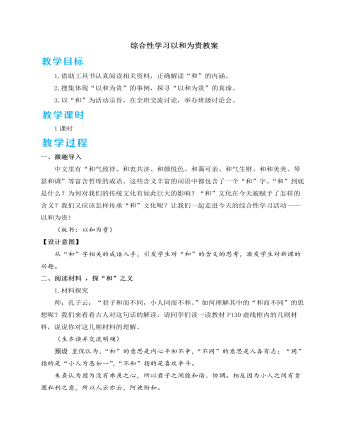
人教部编版语文八年级下册综合性学习以和为贵教案
请同学们阅读教材P133虚线框内的内容,根据要求选择某一新闻事件,开展时事讨论,积极发表看法。提示:学生围绕事件展开讨论,积极发言,认真听取同学的意见,讨论时注意遵守之前制定的“班级议事规则”。(全班讨论,师总结)【设计意图】此环节通过开展班级讨论活动,制定贴近学生生活的“班级议事规则”,将学习的与“和”相关的知识引入实践生活,培养学生运用知识指导生活实践的综合能力。五、以“和”为文,总结收获师:同学们,通过本次综合性学习活动,我们知道了“以和为贵”不仅是为人处世的准绳,也是从政治国的法宝,是处理国际关系的原则,是创建和谐社会的前提条件。通过这次活动,你对中国文化中的“和”一定也有了许多的认识和理解吧!任选一个角度,写一篇不少于600字的作文,谈谈你的收获。
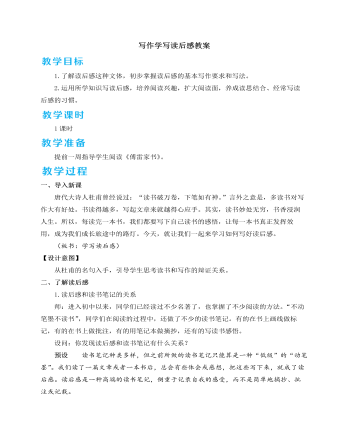
人教部编版语文八年级下册写作学写读后感教案
师小结:本篇习作开篇概述原作内容,抓住要点,简明扼要。感想的内容,先扣住深沉的父爱,表达自己对傅雷的敬意,然后赞美现实生活中父爱的伟大。思路清晰,情感真挚。【设计意图】以《傅雷家书》读后感写作为例,指导学生如何写读后感。重点指导“点引议联结”的基本结构,让学生写作有章可循。四、尝试写读后感1.写作内容师:同学们已经阅读了《傅雷家书》,请大家回顾内容,自拟题目,按照今天讲的写读后感的方法,先列出写作提纲,再写成作文,不少于600字。2.能力提升用已学的读后感知识,修改自己的作文。并反思所写读后感是否有以下不足:(1)以“引”代“感”。读后感,顾名思义,主要是写“感”,引述是为写“感”服务的,但有些同学往往忘记了这一条,本末倒置,大量抄录或复述原文,结果犯了以“引”代“感”、代“联”的毛病。
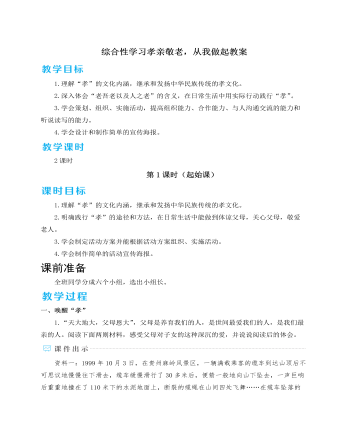
人教部编版七年级下册综合性学习孝亲敬老,从我做起教案
本环节旨在通过展示、评价践行“孝亲敬老”的活动成果,深化 “孝”的境界,培养学生回报家人、关爱他人的美德。展示过程中,学生的语言表达能力、诵读能力、搜集和整理资料的能力、写作能力得到了提升,同时也增强了自信心。二、谈“孝”心1.在这为期一周的践行“孝”的活动中,你有哪些体会和感受?请与大家分享。(生小组内交流,小组代表发言)预设 示例一:在这次践行“孝”的活动中,我做了许多表达孝心的事情,从中体会到了父母工作的艰辛、赚钱的不易,更能体谅他们了。我也了解到平时我不经意说的话伤害了父母,让父母担忧难过了。现在我与父母之间的关系变得更加融洽,父母对我的一些事情也能够理解了,我发现只要我们对父母多一些尊重和理解,他们就会非常开心。示例二:我在采访爷爷奶奶时,了解到祖辈们的人生经历和具体事迹,被他们身上的一些精神品质所感动,更加钦佩他们了。这次的采访活动增强了我与家人之间的沟通,增进了我与家人之间的情感交流,也让我进一步了解了我们家族的一些历史,让我有了为家族努力奋斗的使命感。
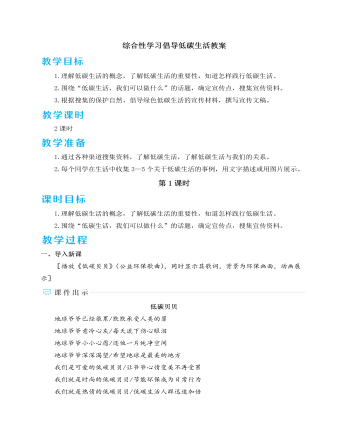
人教部编版语文八年级下册综合性学习倡导低碳生活教案
一是缩小页边距和行间距,缩小字号。正式文件一般对字号、间距有严格的要求,但是在非正式文件里,可适当缩小页边距和行间距,缩小字号。可“上顶天,下连地,两边够齐”,对于字号,以看清为宜。二是纸张双面打印、复印。纸张双面打印、复印既可以减少费用,又可以节能减排。如果全国10%的打印、复印做到这一点,那么每年可减少耗纸约5.1万吨,节能6.4万吨标准煤,相应减排二氧化碳16.4万吨。三是打印时能不加粗、不用黑体的就尽量不用,能节省墨粉或铅粉。此外,能够用电脑网络传递的文件就尽量在网络上传递,比如电子邮件、单位内部网络等,这样下来也可以节约不少纸张。(选自《低碳校园——让我们的学校更美好》,天津人民出版社2013年版)(学生围绕各自任务,课外搜集制作宣传材料,时间为一周。)【设计意图】本环节先从探讨自身在低碳生活中力所能及的事情,让学生切实认识到低碳生活就在日常的一举一动中。然后围绕主题分组,并保证足够的时间,让学生去收集整理资料,落实任务,使学生能真正成为低碳的倡导者和践行者。
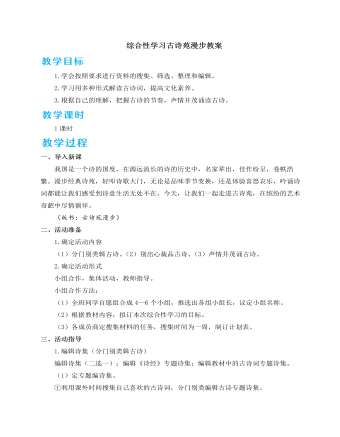
人教部编版语文八年级下册综合性学习古诗苑漫步教案
解说词:画卷上的竹子,在石缝中挺然而立,坚韧不拔,遇风不倒。郑板桥先生借竹抒发了自己的洒脱与豁达,表现了他勇敢面对现实、绝不屈服于挫折的品性,令竹子人格化了。此时,“诗是无形画,画是有形诗”。4.声情并茂诵古诗(播放相关的主题图片和音乐,尽量让诗歌和音乐、画面相融合)主持人:诗除了追求意境的图画美之外,还特别注重节奏和韵律,具有音乐美。我们理解了诗中的情愫后,便可以通过朗读来诠释这种种情愫,或低声絮语,或慷慨悲吟,或温情述说……请大家选择自己最喜欢的一首诗词或一小节诗歌,用你认为最贴切的情感和方式朗读,并说出这样处理的原因,或讲述你与此诗有关的故事。朗读示例:无言/独上西楼,月/如钩,寂寞梧桐/深院/锁/清秋。剪不断,理还乱,是离愁,别是/一般滋味/在心头。解说词:此词是南唐后主李煜被囚于宋时所作,表达了他离乡去国的锥心之痛。朗读时要表现出那种深切的故国之思、亡国之恨。
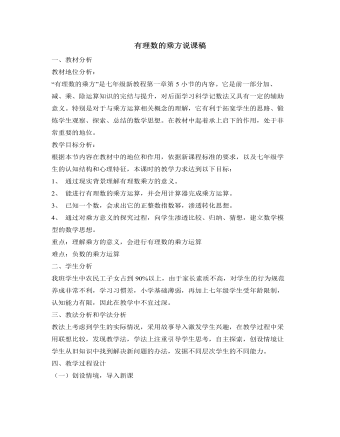
北师大初中数学七年级上册有理数的乘方说课稿
说明:此处进行的是一次尝试应用乘方运算来解决开头的问题,互相呼应,以体现整节课的完整性,把学生开始的兴趣再次引向高潮。趣味探索:一张薄薄的纸对折56次后有多厚?试验一下你能折这么厚吗?说明:这个探索实际上仍是对学生应用能力的一个检查,纸对折56次,用什么运算来计算比较方便,另外计算过程中可使用计算器,进一步加深对乘方意义的理解(五)作业P56页1、2说明:这两个习题是对课本上例题的简单重复和模仿,通过本节课的学习,多数学生应该可以较轻松地完成。总之,在整个教学设计中,我始终以学生为课堂主体,让他们积极参与到教学中来,不断从旧知识中获得新的认识,通过不断进行联系比较,让学生主动自觉地去思考、探索、总结直至发现结果、发现"方法",进而优化了整个教学。








